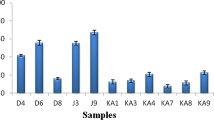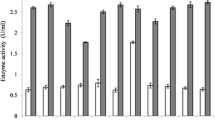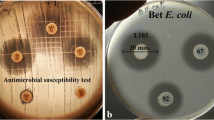Abstract
Capability to produce antilisterial bacteriocins by lactic acid bacteria (LAB) can be explored by the food industry as a tool to increase the safety of foods. Furthermore, probiotic activity of bacteriogenic LAB brings extra advantages to these strains, as they can confer health benefits to the consumer. Beneficial effects depend on the ability of the probiotic strains to maintain viability in the food during shelf-life and to survive the natural defenses of the host and multiply in the gastrointestinal tract (GIT). This study evaluated the probiotic potential of a bacteriocinogenic Lactobacillus plantarum strain (Lb. plantarum ST16Pa) isolated from papaya fruit and studied the effect of encapsulation in alginate on survival in conditions simulating the human GIT. Good growth of Lb. plantarum ST16Pa was recorded in MRS broth with initial pH values between 5.0 and 9.0 and good capability to survive in pH 4.0, 11.0 and 13.0. Lb. plantarum ST16Pa grew well in the presence of oxbile at concentrations ranging from 0.2 to 3.0%. The level of auto-aggregation was 37%, and various degrees of co-aggregation were observed with different strains of Lb. plantarum, Enterococcus spp., Lb. sakei and Listeria, which are important features for probiotic activity. Growth was affected negatively by several medicaments used for human therapy, mainly anti-inflammatory drugs and antibiotics. Adhesion to Caco-2 cells was within the range reported for other probiotic strains, and PCR analysis indicated that the strain harbored the adhesion genes mapA, mub and EF-Tu. Encapsulation in 2, 3 and 4% alginate protected the cells from exposure to 1 or 2% oxbile added to MRS broth. Studies in a model simulating the transit through the GIT indicated that encapsulated cells were protected from the acidic conditions in the stomach but were less resistant when in conditions simulating the duodenum, jejunum, ileum and first section of the colon. To our knowledge, this is the first report on a bacteriocinogenic LAB isolated from papaya that presents application in food biopreservation and may be beneficial to the consumer health due to its potential probiotic characteristics.






Similar content being viewed by others
References
Ammor MS, Flóres AB, Mayo B (2007) Antibiotic resistance in not-enterococcal lactic acid bacteria and bifidobacteria. Food Microbiol 24:559–570
Basson A, Flemming LA, Chenia HY (2008) Evaluation of adherence, hydrophobicity, aggregation characteristics and biofilm development of Flavobacterium johnsoniae-like isolates. Microb Ecol 55:1–14
Bertazzoni-Minelli E, Benini A, Marzotto M, Sbarbati A, Ruzzenente O, Ferrario R, Hendriks H, Dellaglio F (2004) Assessment of novel probiotic Lactobacillus casei strains for the production of functional foods. Int Dairy J 14:723–736
Boekhorst J, Wells M, Kleerebezem M, Siezen RJ (2006) The predicted secretome of Lactobacillus plantarum WCFS1 sheds light on interactions with its environment. Microbiology 152:3175–3183
Botes M, Van Reenen CA, Dicks LMT (2008) Evaluation of Enterococcus mundtii ST4SA and Lactobacillus plantarum 423 as probiotics by using a gastro-intestinal model with infant milk formulations as substrate. Int J Food Microbiol 128:362–370
Brink M, Todorov SD, Martin JH, Senekal M, Dicks LMT (2006) The effect of prebiotics on production of antimicrobial compounds, resistance to growth at low pH and in the presence of bile, and adhesion of probiotic cells to intestinal mucus. J Appl Microbiol 100:813–820
Carvalho KG, Kruger MF, Furtado DN, Todorov SD, Franco BDGM (2009) Evaluation of the role of environmental factors in the human gastrointestinal tract on the behaviour of probiotic cultures Lactobacillus casei Shirota and Lactobacillus casei LC01 by the use of a semi-dynamic in vitro model. Ann Microbiol 59:439–445
Chan ES, Zhang Z (2005) Bioencapsulation by compression coating of probiotic bacteria for their protection in an acidic medium. Process Biochem 40:3346–3351
Chandramouli V, Kailasapathy K, Peiris P, Jones M (2004) An improved method of microencapsulation and its evaluation to protect Lactobacillus spp. in simulated gastric conditions. J Microbiol Meth 56:27–35
Dellaglio F, Bottazzi V, Troatelli LD (1973) Deoxyribonucleic acid homology and vase composition in some thermophylic lactobacilli. J Gen Microbiol 74:289–297
Dicks LMT, Todorov SD, Franco BDGM (2009) Current status of antibiotic resistance in lactic acid bacteria. In: Bonilla AR, Muniz KP (eds) Antibiotic resistance: causes and risk factors, mechanisms and alternatives. Pharmacology—research, safety testing and regulation. Nova Publisher, New York, pp 379–425
Doyle RJ, Rosenberg M (1995) Measurement of microbial adhesion to hydrophobic substrates. Meth Enzymol 253:542–550
FAO/WHO (2001) Evaluation of health and nutritional properties of powder milk and live lactic acid bacteria. In: Food and agriculture organization of the United Nations and World Health Organization expert consultation report. FAO, Rome
Garriga M, Hugas M, Aymerich T, Monfort JM (1993) Bacteriocinogenic activity of Lactobacillli from fermented susages. J Appl Bacteriol 75:142–148
Gilliland SE (1989) Acidophilus milk products: A review of potential benefits to consumers. J Dairy Sci 72:2483–2494
Gomes AMP, Xavier MF (1999) Bifidobacterium spp. and Lactobacillus acidophilus: biological, biochemical, technological and therapeutical properties relevant for use as probiotics. Trends Food Sci Technol 10:139–157
Granato D, Perotti F, Masserey I, Rouvet M, Golliard M, Servin A, Brassart D (1999) Cell surface-associated lipoteichoic acid acts as an adhesion factor for attachment of Lactobacillus johnsonii La1 to human enterocyte-like Caco-2 cells. Appl Environ Microbiol 65:1071–1077
Haller D, Colbus H, Ganzle MG, Scherenbacher P, Bode C, Hammes WP (2001) Metabolic and functional properties of lactic acid bacteria in the gastro-intestinal ecosystem: A comparative in vitro study between bacteria of intestinal and fermented food origin. Syst Appl Microbiol 24:218–226
Jankowski T, Zielinska M, Wysakowska A (1997) Encapsulation of lactic acid bacteria with alginate/starch capsules. Biotechnol Techn 11:31–34
Kailasapathy K (2002) Microencapsulation of probiotic bacteria: technology and potential applications. Curr Issues Intest Microbiol 3:39–48
Kailasapathy K, Chin J (2000) Survival and therapeutic potential of probiotic organisms with reference to Lactobacillus acidophilus and Bifidobacteria spp. Immunol Cell Biol 78:80–88
Kleerebezem M, Boekhorst J, van Kranenburg R, Molenaar D, Kuipers OP, Leer R, Tarchini R, Peters SA, Sandbrink HM, Fiers MWEJ, Stiekema W, Lankhorst RMK, Bron PA, Hoffer SM, Groot MNN, Kerkhoven R, de Vries M, Ursing B, de Vos WM, Siezen RJ (2003) Competitive genome sequence of Lactobacillus plantarum WCFS1. Proc Nat Acad Sci USA 100:1990–1995
Krasaekoopt W, Bhandari B, Deeth H (2003) Evaluation of encapsulation techniques of probiotics for yoghurt. Int Dairy J 13:3–13
Lee KY, Heo TR (2000) Survival of Bifidobacterium longum immobilized in calcium alginate beads in simulated gastric juices and bile salt solution. Appl Environ Microbiol 66:869–873
Levy SB, Marshall B (2004) Antibacterial resistance worldwide: causes, challenges and responses. Nat Med Rev 10:S122–S129
Liserre AM, Re MI, Franco BDGM (2007) Microencapsulation of Bifidobacterium animalis subsp. lactis in modified alginate-chitosan beads and evaluation of survival in simulated gastrointestinal conditions. Food Biotechnol 21:1–16
Mandal S, Puniya AK, Singh K (2006) Effect of alginate concentrations on survival of microencapsulated Lactobacillus casei NCDC-298. Int Dairy J 16:1190–1195
Mollendorff JW (2008) Characterization of bacteriocins produced by lactic acid bacteria from fermented beverages and optimization of starter cultures. McS Thesis, Stellenbosch University, Stellenbopsch, South Africa
Picot A, Lacroix C (2004) Encapsulation of bifidobacteria in whey protein-based microcapsules and survival in simulated gastrointestinal conditions and in yoghurt. Int Dairy J 14:505–515
Ramiah K, Van Reenen CA, Dicks LMT (2008) Surface-bound proteins of Lactobacillus plantarum 423 that contribute to adhesion of Caco-2 cells and their role in competitive exclusion and displacement of Clostridium sporogenes and Enterococcus faecalis EF-Tu protein binds to GTP. Res Microbiol 159:470–475
Rojas M, Ascencio F, Conway PL (2002) Purification and characterization of a surface protein from Lactobacillus fermentum 104R that binds to porcine small intestinal mucus and gastric mucin. Appl Environ Microbiol 68:2330–2336
Roos S, Jonsson H (2002) A high-molecular-mass cell-surface protein from Lactobacillus reuteri 1063 adheres to mucus components. Microbiology 148:2481–2489
Salyers AA, Gupta A, Wang Y (2004) Human intestinal bacteria as reservoirs for antibiotic resistance genes. Trends Microbiol 12:412–416
Schar-Zammaretti P, Ubbink J (2003) The cell wall of lactic acid bacteria: surface constituents and macromolecular conformations. Biophys J 85:4076–4092
Shah NP (2000) Probiotic bacteria: selective enumeration and survival in dairy foods. J Dairy Sci 83:894–910
Sheu TY, Marshall RT (1991) Improving culture viability in frozen dairy desserts by microencapsulation. J Dairy Sci 74:107–112
Sheu TY, Marshall RT (1993) Microencapsulation of lactobacilli in calcium alginate gels. J Food Sci 58:557–561
Sheu TY, Marshall RT, Heymann H (1993) Improving survival of culture bacteria in frozen desserts by microentrapment. J Dairy Sci 76:1902–1907
Suita-Cruz P, Goulet J (2001) Improving probiotic survival rates. Food Technol 55:36–42
Teuber M (1999) Spread of antibiotic resistance with food-borne pathogens. Cell Mol Life Sci 56:755–763
Todorov SD (2009) Bacteriocins from Lactobacillus plantarum–production, genetic organization and mode of action. A review. Braz J Microbiol 40:209–221
Todorov SD, Dicks LMT (2006) Screening for bacteriocin producer lactic acid bacteria from boza, a traditional cereal beverage from Bulgaria. Characterization of produced bacteriocins. Process Biochem 41:11–19
Todorov SD, Dicks LMT (2008) Evaluation of lactic acid bacteria from kefir, molasses and olive brine as possible probiotics based on physiological properties. Ann Microbiol 58:661–670
Todorov SD, Botes M, Danova ST, Dicks LMT (2007) Probiotic properties of Lactococcus lactis subsp. lactis HV219, isolated from human vaginal secretions. J Appl Microbiol 103:629–639
Todorov SD, Botes M, Guigas C, Schillinger U, Wiid I, Wachsman MB, Holzapfel WH, Dicks LMT (2008) Boza, a natural source of probiotic lactic acid bacteria. J Appl Microbiol 104:465–477
Todorov SD, Prévost H, Lebois M, Dousset J, LeBlanc JG, Franco BDGM (2011) Bacteriocinogenic Lactobacillus plantarum ST16Pa isolated from papaya (Carica papaya)—from isolation to application: Characterization of a bacteriocin. Food Res Int 44:1351–1363
Trindade CSF, Grosso CRF (2000) The effect of the immobilization of Lactobacillus acidophilus and Bifidobacterium lactis in alginate on their tolerance to gastrointestinal secretions. Milchwissenschaft 55:496–499
Tuomola EM, Salminen S (1998) Adhesion of some probiotic and dairy Lactobacillus strains to Caco-2 cell cultures. Int J Food Microbiol 41:45–51
Vinderola CG, Reinheimer JA (2003) Lactic acid starter and probiotic bacteria: a comparative in vitro study of probiotic characteristics and biological barrier resistance. Food Res Int 36:895–904
Wadström T, Andersson K, Sydow M, Axelsson L, Lindgren S, Gullmar B (1987) Surface properties of lactobacilli isolated from the small intestine of pigs. J Appl Bacteriol 62:513–520
Acknowledgments
The authors would like to thank Coordenação de Aperfeiçoamento de Pessoal de Nível Superior (CAPES, Brasil), Conselho Nacional de Desenvolvimento Científico e Tecnológico (CNPq, Brasil), and Consejo Nacional de Investigaciones Científicas y Técnicas (CONICET, Argentina) for financial support.
Author information
Authors and Affiliations
Corresponding author
Rights and permissions
About this article
Cite this article
Todorov, S.D., LeBlanc, J.G. & Franco, B.D.G.M. Evaluation of the probiotic potential and effect of encapsulation on survival for Lactobacillus plantarum ST16Pa isolated from papaya. World J Microbiol Biotechnol 28, 973–984 (2012). https://doi.org/10.1007/s11274-011-0895-z
Received:
Accepted:
Published:
Issue Date:
DOI: https://doi.org/10.1007/s11274-011-0895-z




